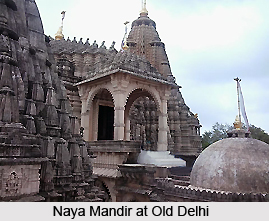 Naya Mandir is a historical Jain temple dedicated to the Jain communities in the region of Dharampura, Old Delhi and was built by the Mughal emperor Aurangzeb. This temple possesses a large collection of manuscripts, especially a unique manuscript of the Maha Purana of Acharya Jinasena belonging to the temple is quite famous. The manuscript can be traced back to the earlier part of the 15th century, particularly to 1420 CE and is a unique instance of Jain architecture. During a certain point of time, Jain temples were equipped with a hidden chamber, which was sometimes referred to as `bhonyra`. Therefore, a concealed room is also existent within the temple premises of Naya Mandir. Presently, the shape of the chamber resembles a cave, appropriate for Jain monks who often engage in deep meditation.
Naya Mandir is a historical Jain temple dedicated to the Jain communities in the region of Dharampura, Old Delhi and was built by the Mughal emperor Aurangzeb. This temple possesses a large collection of manuscripts, especially a unique manuscript of the Maha Purana of Acharya Jinasena belonging to the temple is quite famous. The manuscript can be traced back to the earlier part of the 15th century, particularly to 1420 CE and is a unique instance of Jain architecture. During a certain point of time, Jain temples were equipped with a hidden chamber, which was sometimes referred to as `bhonyra`. Therefore, a concealed room is also existent within the temple premises of Naya Mandir. Presently, the shape of the chamber resembles a cave, appropriate for Jain monks who often engage in deep meditation.
History of Naya Mandir
In the year 1807, the royal treasurer in the later Mughal age known as Raja Harsukh Rai had created an elaborate Jain temple in Old Delhi, during the regime of Akbar. Harsukh Rai was able to attain permission from the Mughal emperor for constructing a `shikhara` for the Jain temple, and this was the very first time a shikhara was being built during the Mughal reign. Therefore, this attributed to the nomenclature of the temple as `Naya Mandir` or New Temple, also to the fact that Old Delhi also contained yet another older temple which is currently known as the Lal Mandir.
However, Harsukh Rai stopped the construction work abruptly and on being questioned by the Agrawal Jain community about the sudden act, he asserted that he required more funds and financial assistance for continuing the erection task of the temple. Rai again started rebuilding the temple following the receipt of modest donations, and claimed that the temple would be recognized as `panchayati` or `belonging to the community`, rather than his own. Eventually, the temple construction was accomplished by him. Unfortunately, during the festive rituals at the time of `Panch-kalyanak Pratisthan` or consecration of the temple, some local vandals raided the temple and plundered numerable silver and gold artefacts which existed here. The utensils, `chhatra` and `chamar` were all looted. Shocked at the incident, Harsukh Rai narrated the burglary to Emperor Akbar, who immediately ordered that all the temple wealth must be restored to the temple grounds.
Architecture of Naya Mandir
The travelogues of several explorers and early visitors to the temple, especially after 1857, have provided a concept about the architecture of the temple as existent during that point of time. A beautiful frontage made of carved stone represents the frontal fa‡ade of the Naya Mandir, in such finery that one would be reluctant to absorb that it is made of stone. A series of stairs would lead one to a courtyard flanked by Moorish arches and also colonnades enriched with groined terraces. Each inch of the colonnade was painted in a detailed manner, which reflected arabesques. The main temple is based near one side of the courtyard, placed over a platform raised about four feet high.
Polished white marble, decorated with flowing floral motifs embedded on the shafts of the arches exist in the interiors of the temple. The ceiling and wall of the Naya Mandir are painted brightly and the other colours utilized are gold and blue. However, the dexterity of the craftsmen has been such that the human eye would witness the artistic work as something similar to a marvellous Kashmiri shawl. The presiding deity of the Naya Mandir is seated at the central portion, just underneath the dome, placed at a height measuring about 10 feet under a white inlaid marble-made baldachino.











